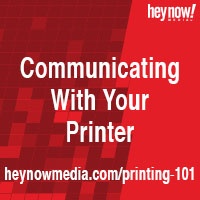The design and print industry is not standardized… not by a long shot. Just because a printer is cheap, doesn’t mean that you will get a good version of what you are printing. Here are a couple tips to navigate the vendor landscape and hopefully help you find a printer who will be a partner and guide through the crazy world of paper weights and crop marks!
1. File Knowledge– A printer should be able to work with an array of files. If they get stuck easily and can’t figure out how to use anything except a pdf that is cause for concern. Printers should be familiar with Adobe Suite, aware of resolution sizes, and catch potential issues.
2. Set-Ups- Some printers charge a set-up fee. This is becoming an antiquated and frankly tacky way to do business. You can’t print without someone on their end setting up the file to match whatever programs they are using, so this fee is really nickel and diming at this point. A true printing partner will not find a way to tack on a bunch of extra charges.
3. Asking the right questions – it’s their industry. They should be providing some insider knowledge that helps you understand how to execute the project better. If they need something specific from you, you can expect a great printer to coach you though what you are looking for and how and who to ask for it. Bonus points if they want to talk to your designer directly to get the job done right.
4. Patient – A printer who will work with you and take the time to get what you need properly is a god send. Once things are in print they are not changeable, so unlike the digital world, all the fixes really have to be made upfront. Someone who is willing to go back and forth with you and the production department to make sure every little thing is right, that’s worth paying for.
5. Solution Minded- A printer that takes the time to look at your project and provide recommendations (ie. Paper stock, printing angles, check the crop (cut) marks, etc.) is huge. Often these days, printing quotes are given via email or over the phone so when it comes to making decisions on which paper to use or how much bleed (margins) to allow, having an expert in your corner who can say “I recommend this” is a good sign that your project will be exactly what you are envisioning.
6. Thorough- when you print something often it’s expensive and high volume. Make sure you have a printer who takes their time and does it right. They should want you to see a sample or proof prior to a big job so you aren’t left with something unusable.





